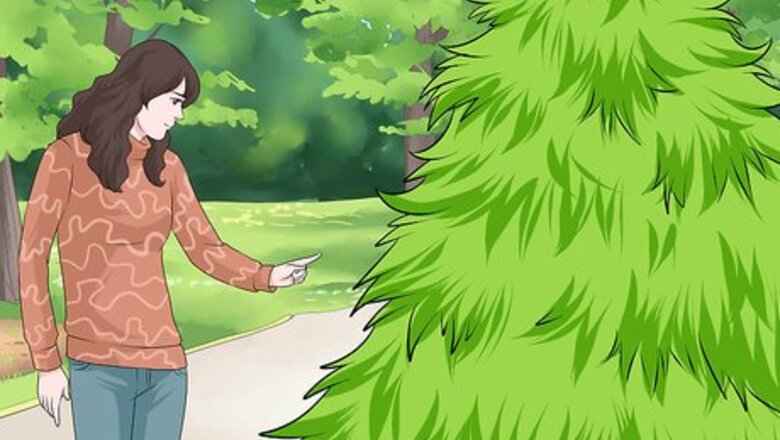
views
Choosing a Live Christmas Tree

Pick out a tree with a good shape to begin with. Pick out the best candidate for a Christmas tree from whatever options you have available. Look out for one that looks full, has an even shape, and has the fewest dead or missing branches. If the tree is pre-cut, have someone hold it up for you so you can walk around and observe the shape and quality from all angles.

Consider the height you need. Measure ahead of time to find out the height of the ceiling where you plan to put your Christmas tree. Take along a tape measure to observe and compare the height of the tree. Note that you will also be adding the height of your tree stand to the total height. Measure the height of your stand ahead of time and factor it into your calculations. You will be able to trim off some height from the trunk of a Christmas tree, but don’t plan on dramatically shortening a tall tree to make it fit in your home. It may be too difficult or impossible to saw off a large portion of the tree.

Consider the width of the tree. Measure the approximate width of the area that you plan to put your Christmas tree so you can find a tree of an equal or lesser width. Note that the branches of a pre-cut tree that has been wrapped or stored against other trees will unfold with time and expand the width of the tree. Take into account the extra width that tree lights and decorations will add later.
Trimming a Live Tree's Trunk and Branches
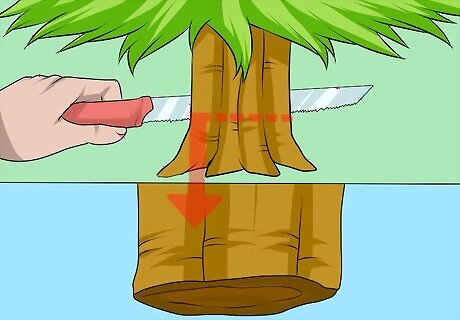
Cut off some of the base. Trim the base of the tree trunk once you take it home. Use a handsaw or chainsaw to remove at least half an inch off the end. If you get your tree from a nursery or store, staff may be able to trim the trunk of the tree for you when you purchase it. Just make sure you are able to get the tree into water shortly thereafter. If you want to shorten the tree slightly to fit the height of your ceiling, cut off a larger portion of the trunk. Just remember that you will likely need a decent section of the trunk clear of branches to fit it into a tree stand. Trimming the trunk is essential to the tree absorbing water and staying fresh, so make sure you cut off at least a half inch even if you don’t need to alter the height at all.
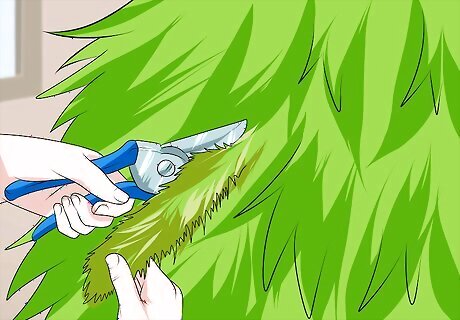
Remove dead or dry branches. Cut off any branches of the tree that appear dead, discolored, or overly dry. Make sure that you are not removing so many branches that there will be large chunks of the tree missing when you’re done. If a tree looks like it has a lot of dry or dead branches to begin with, don’t buy it. Test dry branches by gentling shaking them and observing how many needles fall off; if more than half, the branch is probably too dry. Also bend needles in half; they should snap if from a fir tree and not break at all if from a pine. Use pruning shears, hedge clippers, or a shearing knife to remove any branches.
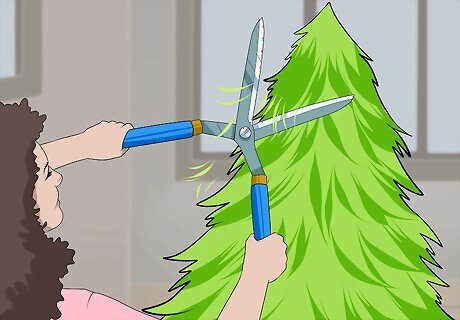
Trim the top of the tree. Locate the most central, vertical branch at the top of your tree and trim it to about 10 inches if it is any longer. The top center branch is important to keep and trim to a sturdy length so you can use it as a support for a tree topper, like a star or angel, if you choose to decorate with one. Remove any other longer branches that appear to be competing for the center branch.
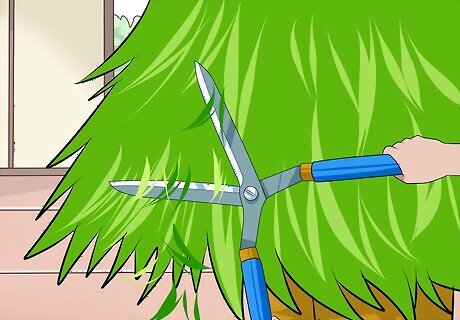
Shape the rest of the branches. Trim the ends of any branches that stick out from the overall shape of the tree, keeping it a generally uniform cone shape, or however you want your tree to look. In general, for the classic look, you’ll want the base of the branches to be widest with the circumference getting gradually smaller as you go up to the top, which ends in a tapered point. The ideal proportion for most Christmas trees is a “two-thirds taper,” which means that the base of the three is two-thirds as wide as the height. So, a six-foot-tall tree would ideally have a four-foot-wide base. Try to cut as little of the branches as possible, sticking to the lighter green new growth. Don’t cut into the old growth (which is characterized by a darker green color, usually) unless you have to.
Preparing a Live Tree for Decorating

Stand your tree in a tree stand. Place your tree upright in a tree stand that can hold about a gallon of water. Avoid shaving the bark off of a tree trunk to get it to fit into a smaller tree stand opening. You want to leave on the outer layers of wood, which are the most efficient in taking up water. Use a tree skirt to cover up the tree stand and create a visually appealing place to put presents. Just remember to lift the skirt up periodically to check and fill the water.
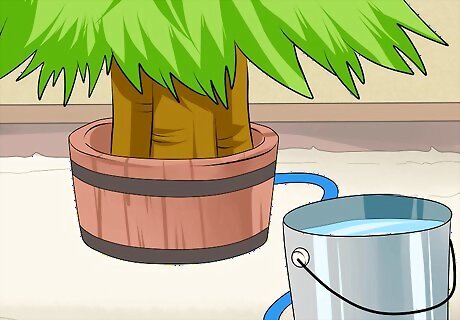
Keep your tree stand full of water. Fill the water trough of your tree stand right away and keep it full at all times with clean, fresh water. A good indication of how much water your tree needs is to measure the diameter of the trunk at its base. The number of inches is the same number of quarts that should be available to your tree in the tree stand. If your tree doesn’t get enough water after being cut, it will form a seal of sap over the cut end, which you will need to cut off to allow it to absorb more water. Try to place your tree in water as soon as possible after it is cut. A Christmas tree watering system will increase the water capacity of your stand and make it easy to add water. Despite some common theories, adding sugary drinks or any other substance to the water in the tree stand does not help the tree to maintain its freshness. Always fill with clean, pure water.
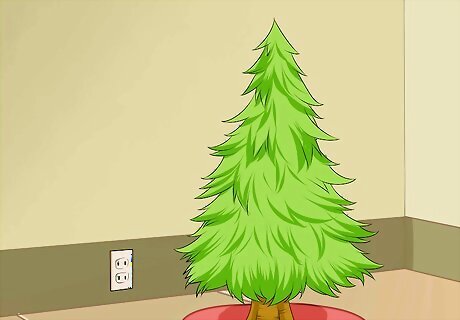
Place the tree near an outlet and away from heat. Choose a location to display your tree that is close to a wall outlet so that you can easily plug in a string of lights. Keep it away from fireplaces or other areas of high heat to avoid a fire hazard and premature drying. You can also lower the temperature of the room that the tree is in to help keep it from drying out as quickly. The branches will dry more and the water will be taken up and evaporate quicker in high heat. If you can’t place a tree near a power outlet, try using an extension cord with a power strip. This will also act as a safety and convenience feature, as you can easily turn off Christmas tree lights once you’ve put them on the tree by using the on/off switch on the power strip.
Decorating Your Christmas Tree
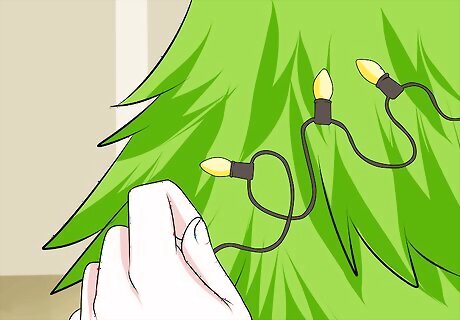
String up lights. Choose the color, size, and length of the lights you want to wrap around your Christmas tree. Determine the ideal length you’ll need by taking a couple measurements of the tree’s circumference with flexible measuring tape. Try opting for a longer string than you think you need, or multiple strings, as the tree will look best with lights weaved into the inside of the tree, not just the outside branches. A good rule is to have a string of 100 lights for every vertical foot of the tree. You can mix and match colors and styles of lights on the same tree. Try smaller traditional incandescent lights in multi-color along with a string of larger white globe lights, for example, to add variety to your tree.
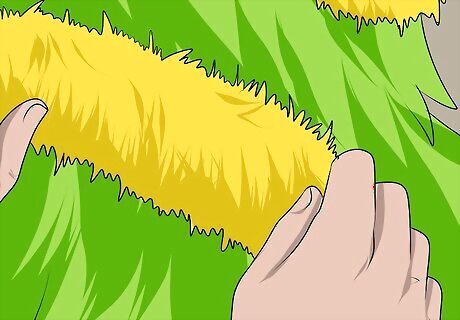
Wrap a garland around the tree. Hang a garland of beads, ribbon, or foil on your tree by loosely draping it over the branches from top to bottom. Try making your own traditional garlands by stringing popcorn kernels or cranberries together. A good rule is to hang a thin garland of berries, beads, or popcorn by draping it across the branches, while a thicker ribbon or foil garland should be wrapped loosely around the tree. You can also add loose tinsel to hang on the garlands, strings of lights, or the branches themselves. Or, find a string of tinsel to hang like a garland for less fallen mess.

Hang your ornaments. Place ornaments on the tree by spacing them evenly throughout all sides of the tree on top and bottom. Try placing your favorite ornaments, whether they’re sentimental or just visually pleasing, up front and in the middle of the tree where you will see them most often. Then space all of your largest ornaments around the tree before filling in with smaller ones. Make sure to hang ornaments, especially fragile ones, securely on the tree by pinching the wire hanger (either provided or one you’ve made with a paper clip) securely around the branch you’re hanging on. Try to hang heavy ornaments close to the tree trunk so they'll be more stable and better supported. You can also add other touches to the tree at this point, like a star or angel tree topper, poinsettia flowers, or other adornments like icicles and snowflakes.













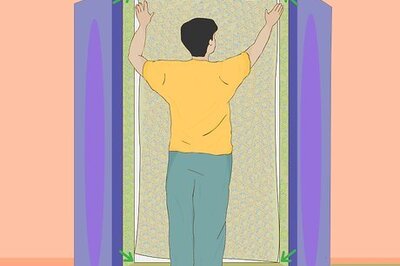





Comments
0 comment